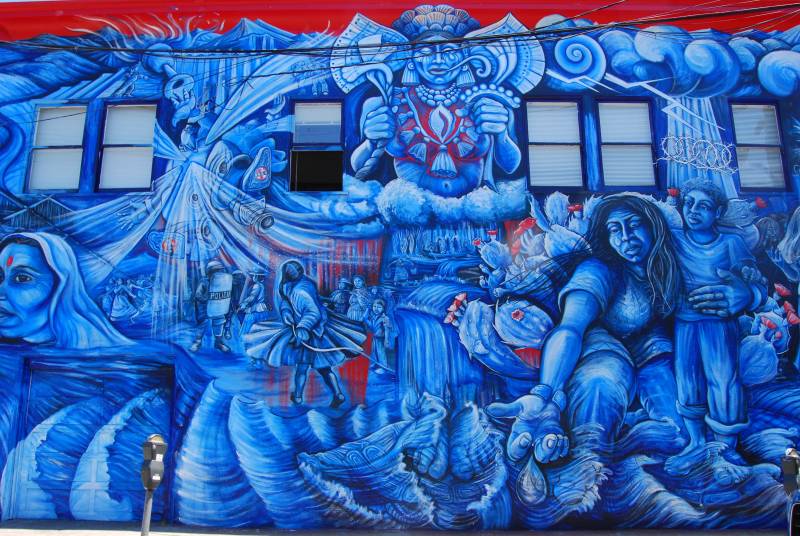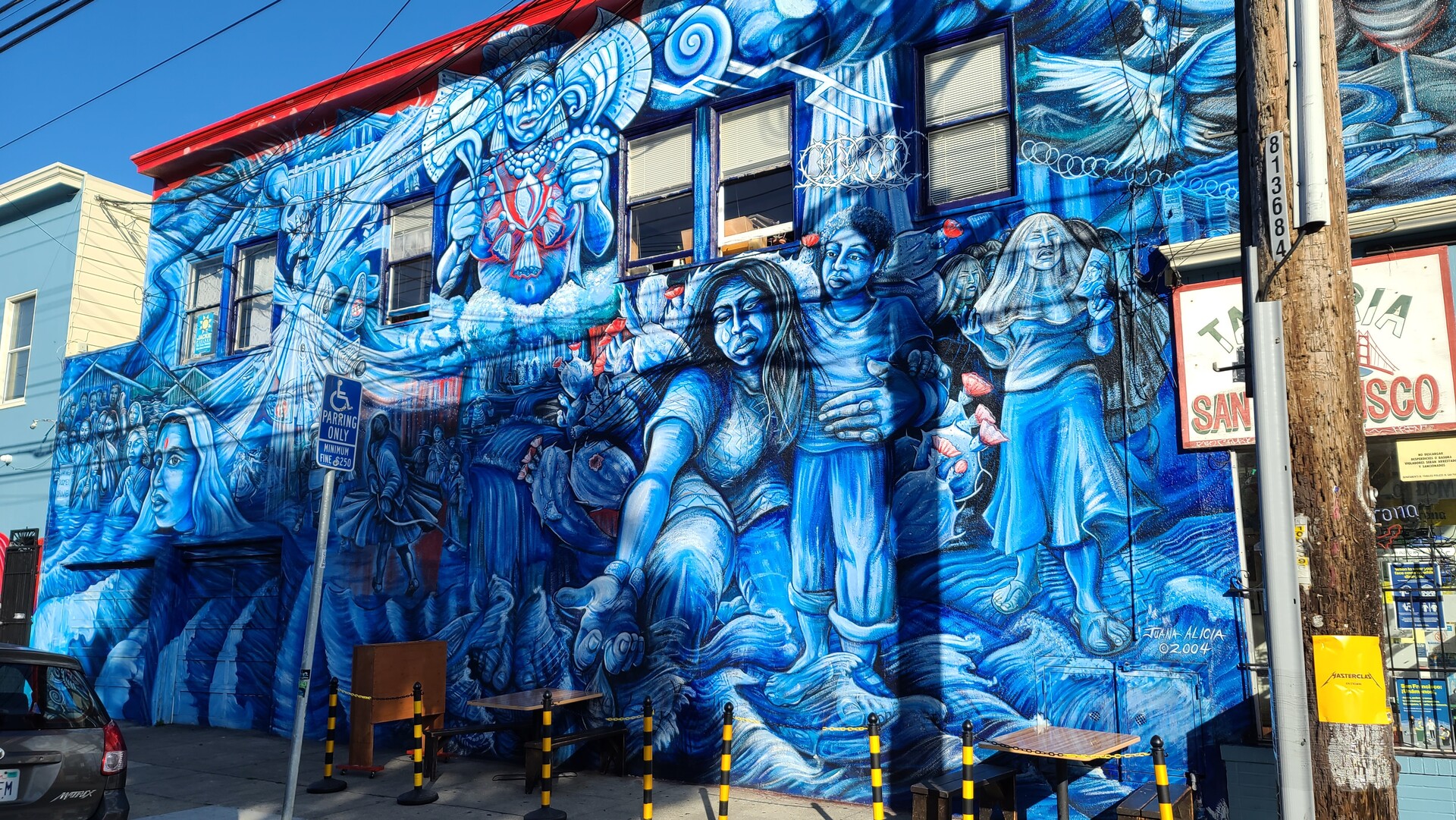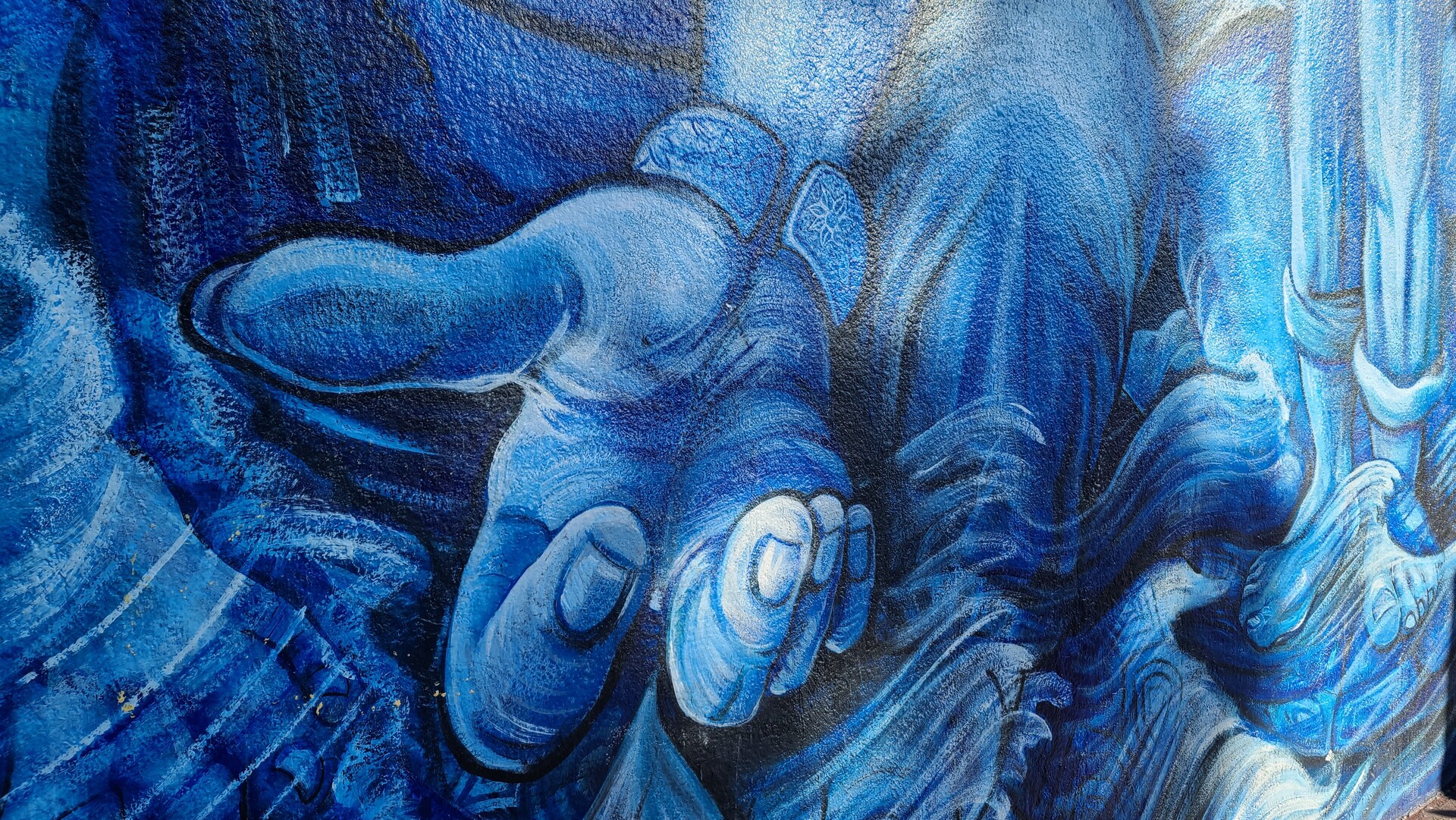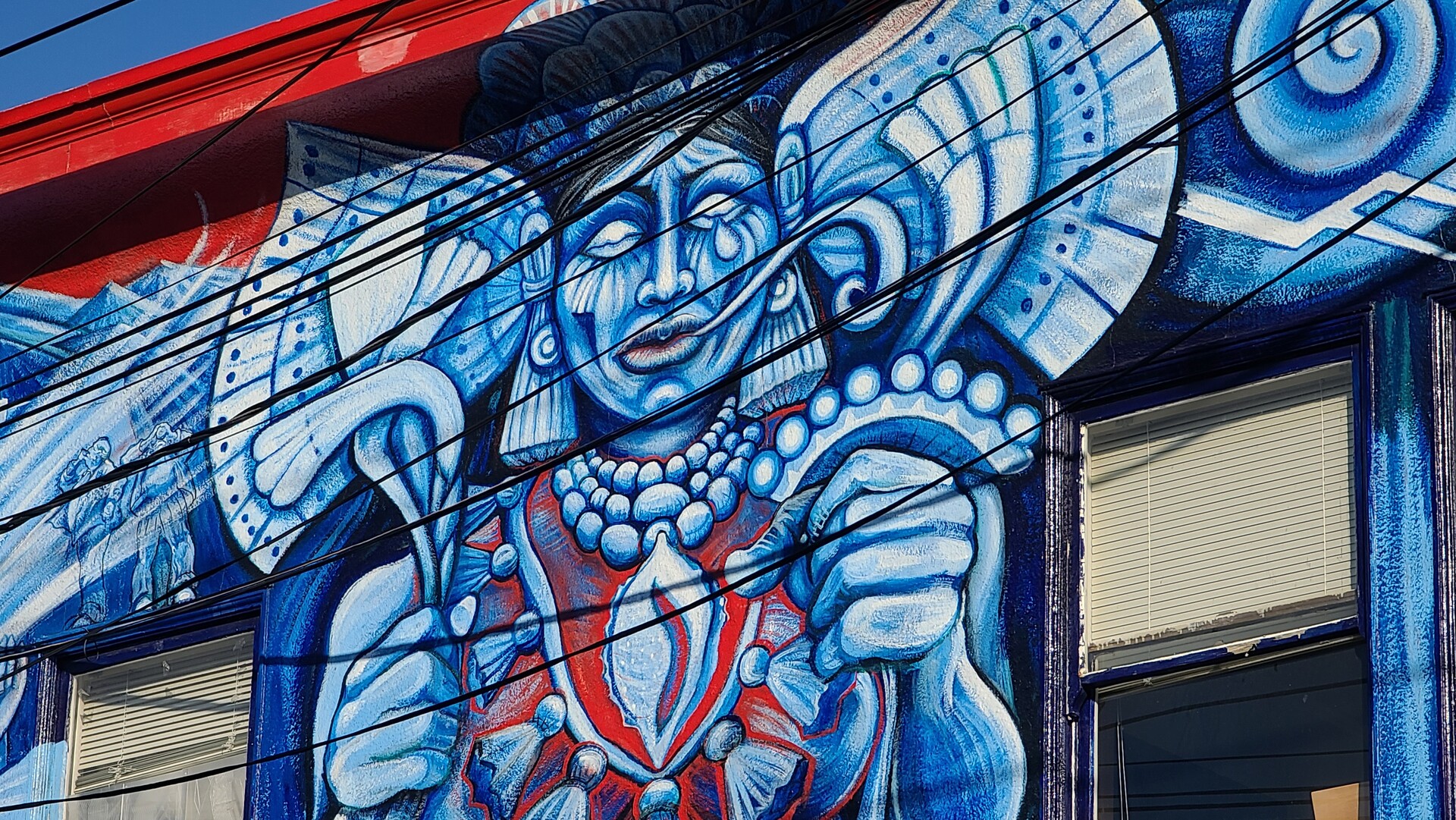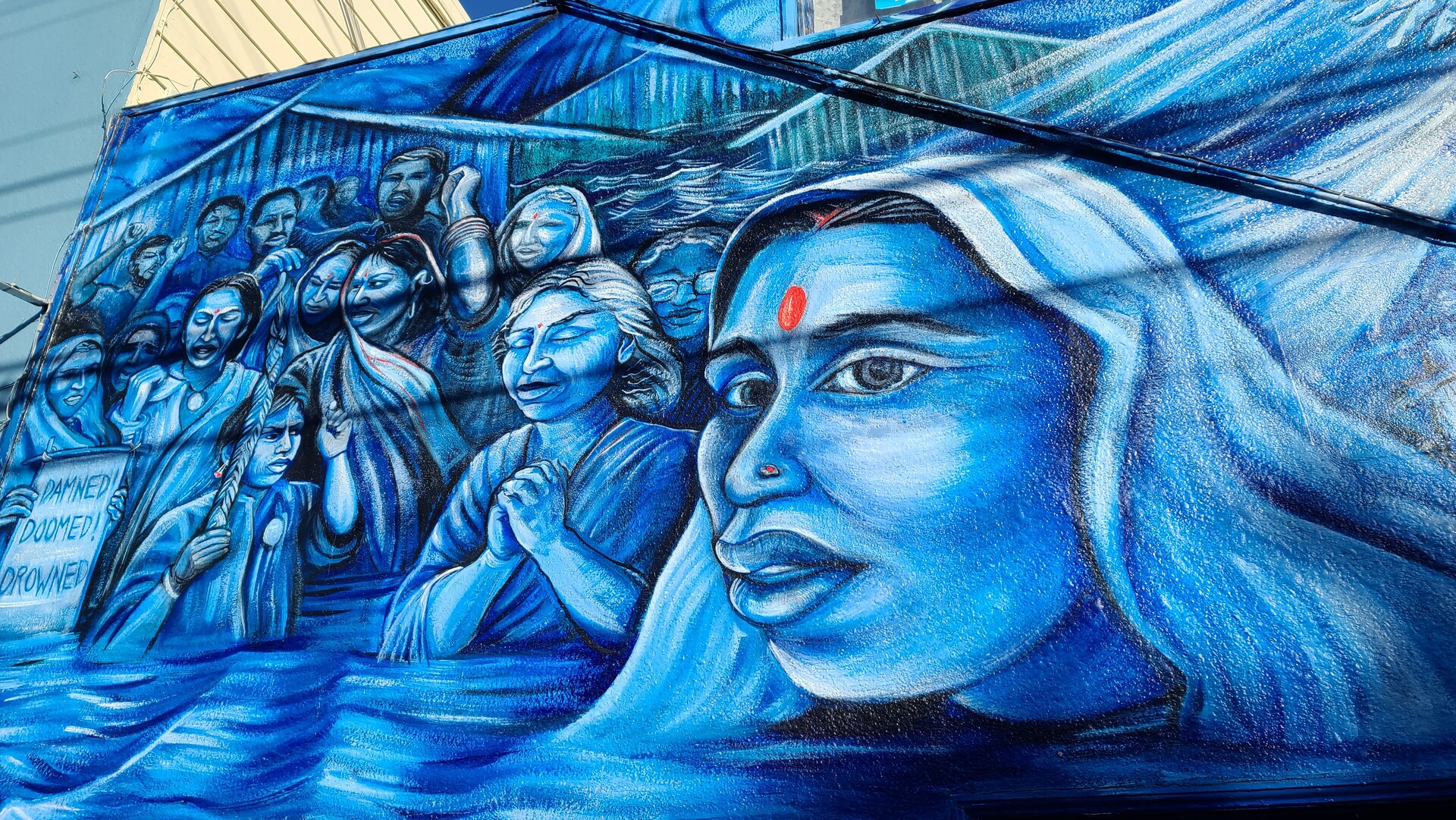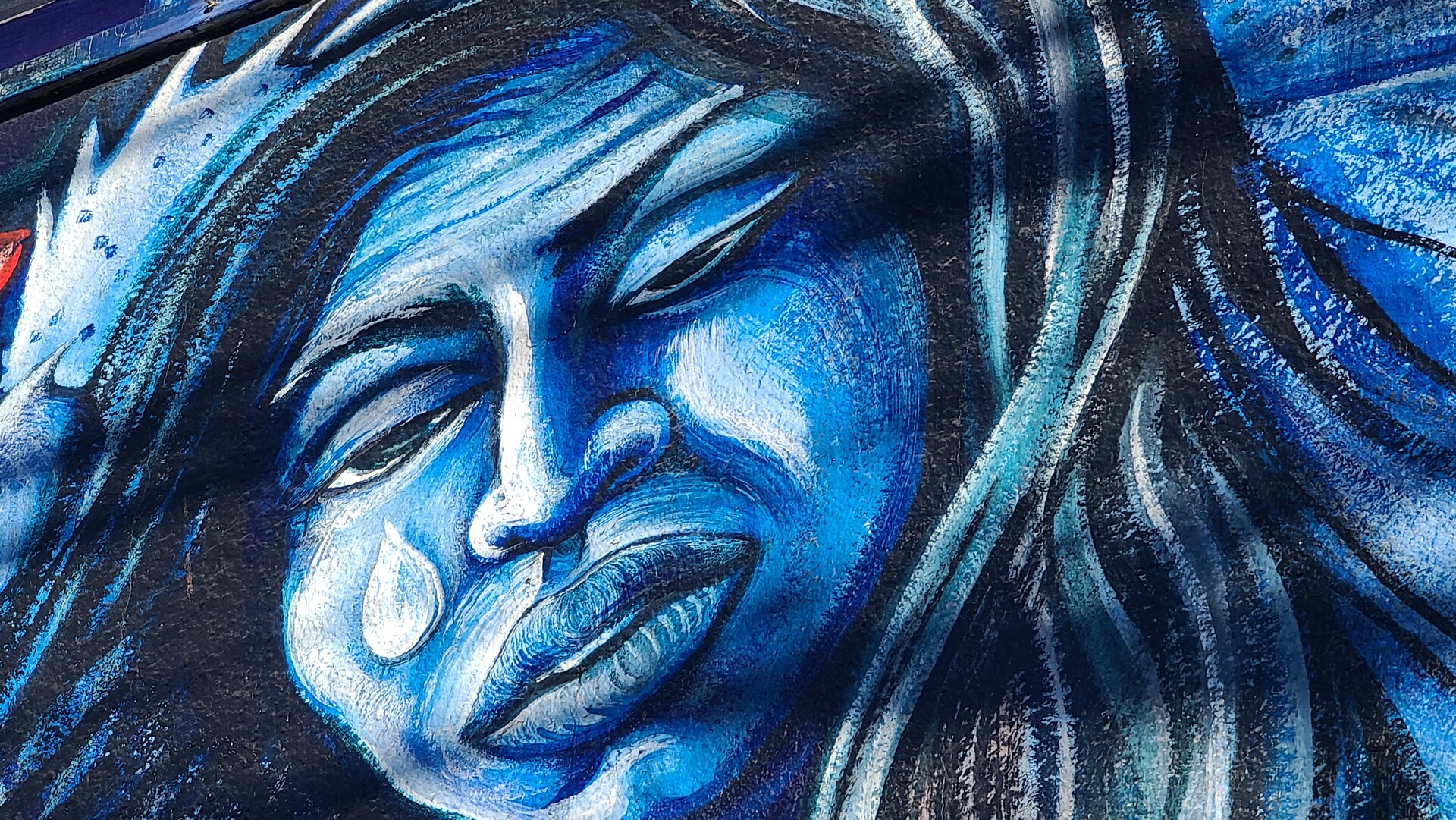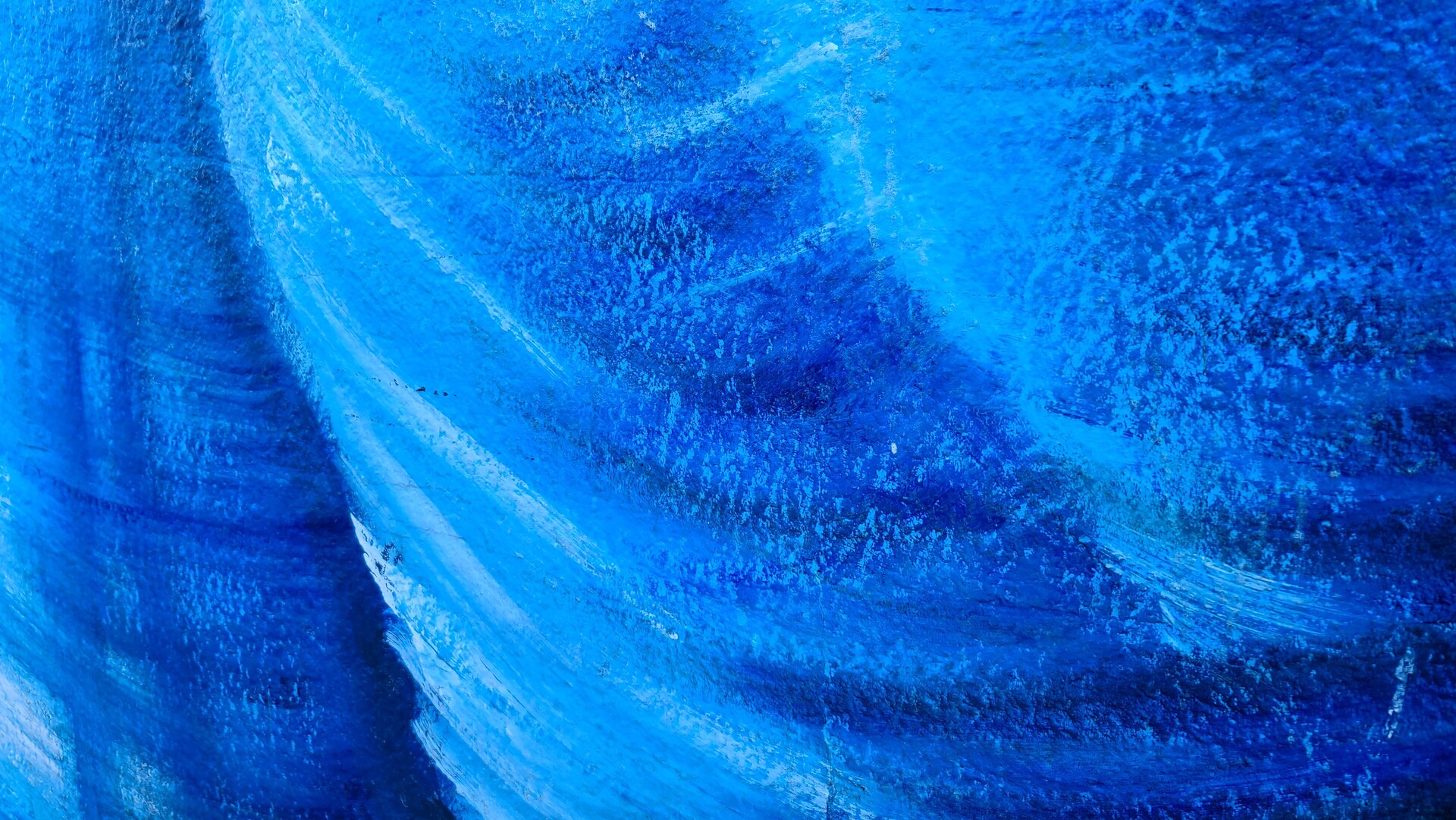Episode Transcript
Katrina Schwartz: In the heart of the Mission District in San Francisco, at the intersection of 24th and York, there’s a massive blue mural — one that will stop you in your tracks.
Standing two stories high and 60 feet long, the intricate mural draws your eyes in with its depth and scale. It’s a world of blue tones, like standing in front of a waterfall. And it’s packed with figures — female figures.
In the center, there’s Chalchiuhtlicue, Aztec goddess of lakes and streams. In the background, there are women from Bolivia, women from India, women from the Mexico-U.S. Border, all standing together.
And in the foreground, there’s a woman standing apart, stretching out her hand, like she’s reaching out to you. A tear falls from her eye, and she’s holding a child in her arms, as if to protect them.
This mural is called “La Llorona’s Sacred Waters”, painted by the Bay Area artist
Juana Alicia. And it’s been a fixture on this San Francisco wall for the last 21 years.
If you’ve grown up with the legend of La Llorona, you might be surprised to see her like this in this mural. Because in the popular telling, the one that’s most common in Mexico and here in California, La Llorona is a ghost — the spirit of a woman who haunts watery places, wailing for her lost children … not protecting them.
To understand how a traditional legend has come this far, and taken so many forms, we’re going to delve deep into the story of La Llorona. This story first aired in 2021, but we’re bring it back in honor of Latino Heritage Month and Spooky October.
I’m Katrina Schwartz and you’re listening to Bay Curious.
Sponsor message
Katrina Schwartz: Today we’re exploring the legend of La Llorona, and how she’s evolved for new generations. Bay Curious reporter Sebastian Miño-Bucheli brings us the story.
Sebastian Miño-Bucheli: For many Latinx people here in California, the story of La Llorona is one you heard growing up — told slightly differently each time.
Gabriella Frenes: My family mainly used it to as like a scare tactic for my mom and my Tias when they were younger.
Sebastian Miño-Bucheli: That’s Gabriella. Because the legend is something that so many people grow up with, I asked her and some of my coworkers what they remember first hearing about La Llorona. Among all the different variations of the legend, there are common themes: the ghost of a weeping woman, who haunts the waters, crying out for her children. Like my coworker Carlos says:
Carlos Cabrera Lomelí: She wails this: like “Mis Hijos, Mis Hijos!” which means my kids, my kids. And they said that she had drowned her own kids and and that she would walk around the rivers where she had the river, where she drowned them, feeling, you know, guilty of what she had done.
Gabriella Frenes: Because you know with the story of La Llorona she drowned her children and she they say that her soul is not rested because she also killed herself. You know, with Catholicism, that’s a huge sin, suicide. And so they say that since her soul is not laid to rest, she’s out there searching for her children.
Sebastian Miño-Bucheli: And because of that, she’s often made into a terrifying ghost, on the lookout for new children — and she wants to take them. Or maybe, as Carlos says, she’s defending something:
Carlos Cabrera Lomelí: She, you know, is looking for them and pushing away anybody that threatens things that are special to her, like her children or rivers. Because rivers, you know, both in Mexico and in the rest of the world can really be the lifeline of a city or a community.
Sebastian Miño-Bucheli: There’s also a traditional song about La Llorona. You might have heard it sung growing up, or, more recently, in the movie Coco:
La Llorona song from the movie “Coco”
Sebastian Miño-Bucheli: I’m Ecuadorian American — and I remember being warned by my childhood friends who were Mexican that if we didn’t behave, La Llorona would come to get us.
But if you only know La Llorona from childhood stories, trust me: this legend goes far beyond those. And it’s the deep history, and the evolution of the legend, that brings us all the way to her very different appearance on that mural by Juana Alicia in the Mission.
I wanted to know more about how the legend of La Llorona got started. So I called up Professora Leticia Hernández, a writer, artist and poet who teaches Oral History at San Francisco State University.
Leticia Hernández: Even though there’s your own myths throughout Latin America, I often associated it more with Mexican culture. And I think that’s how we we hear about it in California or the United States, in the southwest, as mostly associated with Mexican culture.
Sebastian Miño-Bucheli: For many, La Llorona symbolizes Malintzin the woman who was said to have been kidnapped by Hernan Cortes to aid his invasion of Mexico, or helped him by choice, depending on who’s writing the history books. In this telling, La Llorona becomes a symbol of the injustices of colonization.
Leticia Hernández: Some folks say that it starts at, you know, conquest. Others say it predates conquest with all of these incredibly complex and mythical Aztec goddesses and deities, right? Then you have the rendition that you know your honor is associated with, quite like where the Aztec Earth goddess who gave birth to the Sun Moon and stars, and that’s connected to see what that they’re all right, which is the the deity of women who die in childbirth. I mean, it could get really complex there, right?
Sebastian Miño-Bucheli: Professora Hernandez says that even if this legend predates colonization in 1519, the moment Hernan Cortez arrived, the way European colonizers then wrote the history books about Malintzin, or La Malinche, lays the emphasis on her as a negative force — a woman that stepped out of line:
Leticia Hernández: The way that the female figure of La Malinche has been demonized and constructed throughout history is problematic, especially because that that narrative has been controlled by the hetero patriarchy and makes a woman who was most likely a victim into a villain.
Sebastian Miño-Bucheli: There are variations on not just who La Llorona is, but what she’s doing — and what happened to her children.
Leticia Hernández: And there’s a lot of mystery around it, too, right? It’s like, Oh, she was scorned by a lover. So she, you know, drowned her children out of grief. But then she’s grieving forever in this limbo. And that kind of gets close to that whole bad mother narrative, too, right? So super complicated.
Sebastian Miño-Bucheli: Professora Hernandez’s heritage is Salvadoran, and she says so much of the La Llorona legend reminds her of La Siguanaba — a Central American story that shares a lot of DNA with La Llorona. La Siguanaba is a supernatural creature that takes the form of a woman cursed by the river god Lalog, who also stalks the waters, and brings vengeance — upon men and children.
Leticia Hernández: If you look at the legend, it gets more problematic because it becomes more like a spirited girl or a woman with spirit is monstrous. So one version is that Lalog punished her and turned her into Siguanaba for being a bad mother and a bad wife who determines that? What is a bad woman? Why is it bad to have spirit?
Sebastian Miño-Bucheli: Of course, says Professor Hernandez for many people La Llorona is a simple ghost story — and that’s okay:
Leticia Hernández: Sure, I’m wearing my Profe hat right now, but like, Hey, you know, I’m not trying to steal anybody’s scary story or or criticize or even patronize our our our folklore and our, you know, and our sayings. But it is important to know the history and the roots and also how to how to rethink, rethink it.
Sebastian Miño-Bucheli: And to connect us back to Juana Alicia’s mural of La Llorona in the Mission for a moment? Professor Hernandez has actually written about this artwork a bunch — and how it, in her words, “frees the spirit of women from roles as monstrous creatures of folklore to warrior women of history.”
As Juana Alicia herself explains, because La Llorona contains multitudes, she can be used as a symbol for so many things in a mural like this:
Juana Alicia: In the Llorona mural, the issues of water and climate justice and feminism all come up. Racial justice, mixed heritage issues, they’re all there.
Sebastian Miño-Bucheli: On that wall, La Llorona isn’t a ghost — she’s flesh and blood. She’s protecting a child, not threatening it. And remember how my colleague Carlos mentioned how La Llorona is also known to defend the very waters she haunts? You could say she’s playing that water protector role right here, on this mural.
Even where Juana Alicia chose to paint her mural is symbolic:
Juana Alicia: The importance of putting La Llorona, Sacred Waters, on the corner of York and 24th in that neighborhood is multiple. First of all, it’s a neighborhood that I love. But it’s where the Raza is. It’s where people were being evicted rapidly. [11:29:51:11] Again, it’s like an anchor. It’s like a cultural anchor. It’s like holding on to sacred space in a neighborhood that I could no longer afford to live in, and most of my compatriots could not afford to live in either.
Sebastian Miño-Bucheli: La Llorona can be a symbol of complex womanhood; of being torn between two worlds. But also of loss, of many kinds. How people interpret her can be incredibly personal. Just ask journalist Lina Blanco, my colleague here at KQED:
Lina Blanco: The figure of La Llorona, as like a ghost who wanders at night? It was never one that scared me. Because I’ve seen scary things in my life that are not about a ghost wandering at night wanting to steal children.
Sebastian Miño-Bucheli: For Lina, La Llorona wasn’t someone to be afraid of. The legend, as she learned it from the work of Latinx writers and musicians, was more of someone to learn from.
Lina Blanco: The stories of La Llorona that I gravitated to never showed La Llorona as a victim, never showed layered as a vengeful spirit, but instead showed this model of someone who was looking, but then also a bridge and a connecting force between the world that is living and the world that is dead.
Sebastian Miño-Bucheli: As a queer, mixed Chicana coming of age in different places, Lina said she didn’t see something to fear in the story of La Llorona. Instead she saw… parts of herself.
Because La Llorona wanders in the night making those sounds because she’s grieving. She’s in pain, and showing it, and sometimes… other people can find grief kinda frightening.
Lina Blanco: I think also one thing that I’ve learned from grief, whether or not this this mother figure La Llorona lost her kids because she killed them, or lost them because they they were lost to the dark night or by colonization, whatever it is, I think when someone is grieving and when someone is holding on to a deep loss, people fear that too. They don’t know how to engage with someone experiencing grief. They shy away. And so not being able to hold someone in their grief sometimes shows up as ignoring them, fearing them, casting them aside.
Sebastian Miño-Bucheli: For Lina, the way La Llorena grieves isn’t scary — it’s relatable. Because she knows how it feels to be misunderstood this way.
Lina Blanco: And having experienced grief as a young kid, no one knew what to do with me, no one knew how to talk to me. And then they were like, They let me go into this fantasy world of my own to find my own ways of navigating through that. So I was on the other side. I lost my mom. She didn’t lose me, but I lost my mom. So I. Parts of me have gone around the world calling out for for her. And that’s why I feel the connection to, you know, someone who goes looking for their loved ones who are gone. We all do some of that.
Sebastian Miño-Bucheli: Just like the story of La Llorona shifts and evolves, so does that song about her. It takes on new words, gets new verses. And this is the version Lina herself likes to sing:
Lina Blanco: (Singing) La Llorona, La Llorona…
Sebastian Miño-Bucheli: And maybe, on one of these colder nights, just as the sun is starting to set, you’d like to head over to the Mission District and encounter La Llorona on that huge mural by Juana Alicia.
If you’ve only heard the ghost story she might not look exactly like you expect. But if there’s one thing about La Llorona? It’s that she keeps her power to surprise.
Lina Blanco singing
Katrina Schwartz: That story was reported by Sebastian Miño-Bucheli, and edited by Carly Severn.
Tape from the interview with Juana Alicia is courtesy of the San Francisco Museum of Modern Art. It was recorded as part of their Mission Murals Project, which documents the Latinx mural-making culture that emerged in San Francisco’s Mission District during the 1970s.
You can see the mural, “La Llorona’s Sacred Waters,” at 24th and York Street in San Francisco. We’ve also got a picture online at BayCurious.org.
Our show is a production of member-supported KQED in San Francisco.
Bay Curious is made by Gabriela Glueck, Christopher Beale and me, Katrina Schwartz.
With extra support from Maha Sanad, Katie Sprenger, Jen Chien, Ethan Toven-Lindsey and everyone on team KQED.
